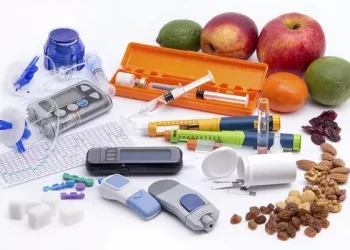Blood sugar, also known as blood glucose, is a crucial parameter in maintaining overall health. Glucose is the primary source of energy for our body’s cells, and its levels are tightly regulated by a complex hormonal system. Among the various times of the day when blood sugar levels are monitored, the pre – dinner blood sugar level holds significant importance. It provides valuable insights into how the body has been processing glucose throughout the day and can help in making informed decisions about diet, exercise, and overall diabetes management.
Understanding Blood Sugar Regulation
The Role of Insulin and Glucagon
The pancreas plays a central role in regulating blood sugar levels. When blood sugar rises, such as after a meal, the pancreas releases insulin. Insulin acts as a key that unlocks the cells, allowing glucose to enter and be used for energy. As glucose enters the cells, blood sugar levels in the bloodstream decrease. On the other hand, when blood sugar levels drop, the pancreas releases glucagon. Glucagon signals the liver to break down stored glycogen into glucose and release it into the bloodstream, thus raising blood sugar levels. This delicate balance between insulin and glucagon ensures that blood sugar remains within a healthy range.
Other Hormonal and Neural Influences
In addition to insulin and glucagon, other hormones also impact blood sugar regulation. Cortisol, the stress hormone, can increase blood sugar levels by promoting the breakdown of glycogen in the liver. Epinephrine, released during the fight – or – flight response, also raises blood sugar by stimulating the release of glucose from the liver. Neural signals from the brain can also influence blood sugar regulation, especially in response to hunger or satiety cues.
Ideal Blood Sugar Levels Before Dinner
For Non – Diabetic Individuals
In healthy individuals without diabetes, the pre – dinner blood sugar level typically ranges from 70 to 100 mg/dL (3.9 to 5.6 mmol/L). This range is considered normal because it indicates that the body is efficiently regulating blood sugar throughout the day. A pre – dinner blood sugar level within this range suggests that the individual’s diet, physical activity, and overall metabolic function are in harmony. For example, if a person has had a balanced breakfast and lunch, with appropriate amounts of carbohydrates, proteins, and fats, and has engaged in some physical activity during the day, their body is able to maintain blood sugar at a healthy pre – dinner level.
For Individuals with Diabetes
Type 1 Diabetes
For those with type 1 diabetes, where the pancreas produces little to no insulin, the pre – dinner blood sugar target may be slightly broader, usually between 90 and 130 mg/dL (5.0 to 7.2 mmol/L). This is because managing blood sugar in type 1 diabetes is more challenging as it requires exogenous insulin injections or the use of an insulin pump. A slightly higher target range helps to prevent the risk of hypoglycemia (low blood sugar), which can be dangerous and even life – threatening in type 1 diabetes patients.
Type 2 Diabetes
In individuals with type 2 diabetes, the pre – dinner blood sugar target can vary depending on the stage of the disease and the treatment plan. Generally, a target range of 80 to 130 mg/dL (4.4 to 7.2 mmol/L) is often recommended. However, in some cases, if the patient has other comorbidities such as heart disease, a more individualized approach may be taken, and the target may be adjusted accordingly. For instance, if a type 2 diabetes patient is on oral medications and is relatively healthy otherwise, the lower end of the range may be more achievable. But if they also have heart disease, a slightly higher pre – dinner blood sugar target might be set to avoid the stress of low blood sugar on the cardiovascular system.
Factors Affecting Pre – Dinner Blood Sugar Levels
Diet
Carbohydrate Intake:Carbohydrates have the most significant impact on blood sugar levels. Simple carbohydrates, such as those found in sugary drinks, white bread, and pastries, are quickly digested and absorbed, causing a rapid spike in blood sugar. If a person has consumed a large amount of simple carbohydrates at lunch, their pre – dinner blood sugar may still be elevated. Complex carbohydrates, on the other hand, like whole grains, legumes, and vegetables, are digested more slowly, resulting in a more gradual rise in blood sugar. A lunch rich in complex carbohydrates is more likely to lead to a stable pre – dinner blood sugar level.
Protein and Fat:Protein and fat can also influence blood sugar levels, although to a lesser extent than carbohydrates. Protein can help slow down the digestion of carbohydrates, which in turn can prevent a sharp increase in blood sugar. For example, if a meal contains a good amount of lean protein like chicken or fish along with carbohydrates, the protein can delay the absorption of glucose from the carbohydrates. Fat also has a similar effect. A diet high in healthy fats, such as those from avocados, nuts, and olive oil, can help regulate blood sugar by reducing the rate of carbohydrate digestion.
Physical Activity:Regular physical activity can have a profound impact on pre – dinner blood sugar levels. Exercise increases the sensitivity of cells to insulin, meaning that the cells can take up glucose more efficiently. If a person engages in moderate – intensity exercise, such as brisk walking or cycling, in the afternoon, it can lower their pre – dinner blood sugar. This is because the muscles use glucose for energy during exercise, and the improved insulin sensitivity allows the body to better utilize the remaining glucose in the bloodstream. However, excessive exercise without proper carbohydrate intake can also lead to low blood sugar, so it’s important to balance exercise with diet.
Medications
Diabetes Medications
For individuals with diabetes, medications play a crucial role in controlling blood sugar levels. Insulin, whether injected or delivered via a pump, directly lowers blood sugar by facilitating glucose uptake into cells. Oral medications for type 2 diabetes, such as metformin, sulfonylureas, and DPP – 4 inhibitors, work in different ways. Metformin reduces glucose production in the liver and improves insulin sensitivity, while sulfonylureas stimulate the pancreas to release more insulin. These medications need to be carefully timed and dosed to achieve the desired pre – dinner blood sugar levels.
Other Medications
Some non – diabetes medications can also affect blood sugar. For example, corticosteroids, which are used to treat conditions like asthma and autoimmune diseases, can increase blood sugar levels. Beta – blockers, used for high blood pressure and heart conditions, may interfere with the body’s ability to recognize and respond to low blood sugar. It’s important for patients on these medications to be aware of their potential impact on blood sugar and to monitor their levels regularly.
Importance of Monitoring Pre – Dinner Blood Sugar
For Diabetes Management
Adjusting Treatment Plans:Monitoring pre – dinner blood sugar levels is essential for diabetes management. If a patient’s pre – dinner blood sugar is consistently higher than the target range, it may indicate that their current treatment plan, whether it’s diet, exercise, or medication, needs adjustment. For example, if a type 2 diabetes patient on oral medications has elevated pre – dinner blood sugar, their doctor may consider increasing the dosage of the medication or adding a new medication. Conversely, if the pre – dinner blood sugar is consistently low, the treatment plan may need to be adjusted to prevent hypoglycemia.
Preventing Complications:Maintaining optimal pre – dinner blood sugar levels can help prevent long – term complications associated with diabetes, such as nerve damage, kidney disease, and eye problems. By keeping blood sugar in a healthy range, the risk of damage to blood vessels and nerves is reduced. For instance, high blood sugar over time can damage the small blood vessels in the eyes, leading to diabetic retinopathy. Monitoring pre – dinner blood sugar is an important step in the overall prevention of these complications.
Conclusion
In conclusion, the optimal blood sugar level before dinner varies depending on whether an individual has diabetes or not. For non – diabetic individuals, a range of 70 to 100 mg/dL (3.9 to 5.6 mmol/L) is considered normal, while for those with diabetes, the target ranges are adjusted based on the type of diabetes and other individual factors. Diet, physical activity, and medications all play significant roles in determining pre – dinner blood sugar levels. Monitoring these levels is crucial for diabetes management, as it allows for timely adjustments to treatment plans and helps prevent complications. Moreover, for non – diabetic individuals, it can serve as an early indicator of potential metabolic problems. By understanding and maintaining optimal pre – dinner blood sugar levels, individuals can take an important step towards better health and a reduced risk of diabetes – related and other metabolic disorders.























